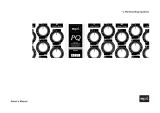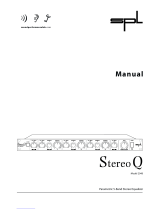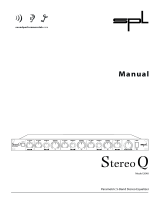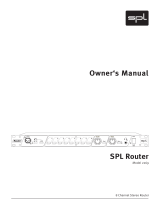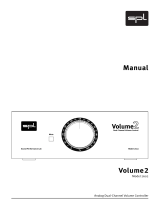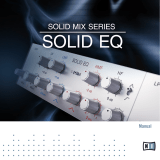Page is loading ...

Owner‘s Manual
> PQ Mastering Equalizer

2
Analog, dual-channel fi ve-band parametric equalizer
Owner‘s Manual V 1.4, 9/2003
Software version 240H
R & D: Wolfgang Neumann
The information in this document has been carefully verifi ed and is assumed to be
correct. However Sound Performance Lab (SPL) reserves the right to modify the
product described in this manual at any time. Changes without notice. This document
is the property of SPL and may not be copied or reproduced in any manner, in part or
full without the authorization of SPL.
Limitations of Liability:
In no event will SPL be liable for any damages, including loss of data, lost profi ts,
cost of cover or other special, incidental, consequential or indirect damages arising
from the use of the unit, however caused and on any theory of liability. This limita-
tion will apply even if SPL or an authorized dealer has been adviced of the possibility
of such damage.
Sound Performance Lab
SPL electronics GmbH
P.O. Box 1 2 27, D- 41368 Niederkruechten, Germany
Phone +49 2163 983 40
Fax +49 2163 983 420
Email: info@soundperformancelab.com
www.soundperformancelab.org
© 2003 SPL electronics GmbH
All rights reserved. Technical specifi cations and appearance are subject to change
without notice.
PQ Mastering Equalizer, Model 2050 Owner‘s Manual

3
Content
Introduction 3
Installation 4
Technology 5
Key Functions 6
Channel Control Elements 8
Technical Specifi cations 10
Warranty 11
Introduction
Dear customer,
thanks for using the PQ Mastering Equalizer. We wish you have as much fun working
with it as we had during the development of this extraordinary equalizer.
Supplied parts
• PQ Mastering Equalizer
• External power supply transformator including both power cords
• Owner’s Manual
Key features
• Pure analog, discrete Class A equalization circuitry
• Digital storability and total recall with motorized controls and 800 presets
• Constant Q and proportional Q modes, selectable per fi lter band
• 124 V internal operating voltage for clean, consistent audio
• Discrete SPL SUPRA op-amps with 150 dB dynamic range
• Channel link mode for stereo applications
• Master/slave unit link mode for surround applications or subgroup processing
allows remote control of up to four PQs via optional remote unit (still in
development)
• As with all SPL products, the PQ is conceived, designed and hand-built in Germany

4
Installation
BEFORE SWITCHING ON POWER SUPPLY AND PQ, THE PQ MUST BE CONNECTED TO
THE POWER SUPPLY WITH THE SUPPLIED MULTICORE LEAD. PAY ATTENTION TO A
SECURE CONNECTION.
The PQ and the external power supply should be situated away from heat sources
and direct sunlight. PQ and power supply need suffi cient air circulation. Avoid instal-
lation in environments exposed to vibrations, dust, heat, cold, moisture or electrical
and magnetic fi elds.
Do not install the unit in proximity to power amplifi ers or digital processors. You
may consider placing it in a rack containing other analog gear. Such placement can
prevent interference from Word Clock, Smpte, MIDI, etc.
• Do not open the case. You may risk electric shock and may damage your equip-
ment.
• Leave repairs and maintenance to a qualifi ed service technician. Should foreign
objects fall inside the case, contact your authorized dealer or support person.
• To avoid electric shock or fi re hazards do not expose your unit to rain or damp-
ness.
• In case of lightning unplug the power supply. Please unplug the cable by pulling on
the plug only; never pull on the cable.
• Never force a switch or knob.
• To clean the case use a lint-free cloth. Avoid cleaning agents as they may damage
the chassis.
• Please support the back of the unit whenever it is being mounted into a 19 inch
rack (especially important when touring).
Setting the appropriate supply voltage
The appropriate supply voltage (115 V/230 V) must be set on the rear panel of the
external power supply. The fuse block (left from the power cord socket) can be
inserted in two positions to meet your country‘s power requirements. Refer to the
marks on the fuse block (triangles for both voltages) and insert the block with the
appropriate triangle pointing to the white line on the fuse block case.
The power supply is fi tted with 3,5 A fuses, slow blow.
Power-up sequence
It takes about four seconds until the power-up sequence is completed. During this
procedure, all potentiometers will move to the center (12 o’clock) position and a test
routine checks all 32 relays (you will notice 32 clearly audible relay clicks), while the
display indicates “SETP ” (“setup”).
After fi nishing the power-up sequence the display shows A000 and the unit is ready
to operate.
Ground Lift switch
A switch labelled „GND LIFT“ is placed on the rear panel of the power supply. It serves
to eliminate hum problems. This switch physically separates chassis ground from AC
ground; GND LIFT is activated (=chassis ground separated) when the switch points
downwards.

5
SPL High Gain Technology
SPL is constantly pushing analog signal processing to its limits by combining the best
possible components with perfectly optimized circuit design. As our latest achieve-
ment in this ongoing process, SPL‘s High Gain Series surpasses the hitherto accepted
limits of audio signal processing and combines truly unparalleled analog sound
quality with the control and convenience of digital units.
The fi rst High Gain Series product, the parametric equalizer PQ, was introduced
at the AES Convention 2001 in Amsterdam and will be available in summer 2002.
Further High Gain projects are in planning, including a microphone preamplifi er and
a compressor, although no availability projections can be made for these currently.
The PQ is a fully parametric, dual-channel 5-band equalizer. As with all SPL High Gain
units, the PQ has an operating voltage of 124 V and is constructed with the best
analog components available.
Power for sound: SPL SUPRA components
The central component of the PQ is a fundamentally new amplifi cation design:
discrete, custom made Class A audio operational amplifi ers which run on a 120 V
operating voltage (+/- 60 V). This amounts to over three times the operating voltage
found in most high quality audio gear (+/- 15-20 V) and about twice as much as the
highest voltages used in the best units currently available.
This extremely high voltage allows the circuitry to process an astonishing dynamic
range of ca. 150 dB and an amazing +34 dB of headroom, virtually eliminating
overloading of individual fi lter stages—even when processing extremely high-level
signals.
For the fi rst time, transistor circuits with such an impressive degree of stability and
freedom from harmonic distortion can be realized. After the revival of tube units in
the early ‘90s, we feel that the time may be ripe for a revival of the „transistor sound“
in the near future.
Additional construction features
All crucial resistors in the I/O and fi lter circuits are subject to ultra-tight tolerances of
0.001% to ensure clean and accurate amplifi er stage performance. All circuit board
tracks are double-width (1 mm) and double-thickness (70 micrometers), guaranteeing
stable high-gain operation with minimum resistivity. A separate grounding track is
placed between signal track pairs, virtually eliminating crosstalk for maximum signal
separation.
The individually switchable fi lter bands are self-contained on separate circuit boards.
Contrary to most conventional equalizers, the bands are not summed via a central
stage, so that the signal passes only through those fi lter stages which are activated.
Technology

6
Constant Q and proportional Q modes
Each frequency band consists essentially of two fully parametric equalizers: one for
constant Q mode and one for proportional (or variable) Q mode, selectable per band.
The PQ is the fi rst equalizer to offer both modes, endowing it with double equaliza-
tion power for demanding corrective and creative applications.
In constant Q mode, the selected bandwidth remains unaffected by the amplitude
setting, making it the best choice for corrective applications (e.g. to eliminate
unwanted frequencies). In proportional Q mode, the amplitude is reduced as the
bandwidth is raised and vice versa. With the smallest bandwidth setting, the
maximum amplitude reaches +/- 11.5 dB, while it is reduced to +/- 2.5 dB with the
broadest bandwidth setting. The Proportional Q mode is better suited for creative,
sound-shaping applications, as a bandwidth-related amplitude allows for sensible,
musically suggestive operation – with raising bandwidths, higher amplitudes are
increasingly less useful.
Controls
All variable controls are motorized and all keys are digitally controlled to provide the
same programmability and repeatability of digital units. Individual settings can be
stored in up to 800 presets.
Link mode
Channel 1 and 2 can be linked for coherent stereo operation and either channel can
be designated as master. In link mode, coupled bands can be activated/deactivated
simultaneously, while single bands may also be released from link mode if required
for individual adjustment.
Master/Slave (unit link) mode
The PQ offers a Master/Slave mode for surround applications or subgroup processing,
in which the settings on the master unit are precisely duplicated on the slave units.
Thus the PQ is the fi rst EQ system that provides up to eight channels for coherent
analog equalization of surround recordings.
Remote Control Unit
SPL offers a remote control unit with an identical user interface to the PQ, which will
be able to control up to four units—individually or in common.
Display
A central display clearly indicates all information relating to preset, storage and
control functions. The control logic is clear and intuitive without menu layers, guar-
anteeing quick and easy operation and a minimal learning curve.
Key Functions

7
Key Functions
Motorized potentiometers
All of the PQ‘s potentiometers are motorized to accommodate the channel link and
unit link functions. The adjustment range of the Frequency, Bandwidth and Amplitude
potentiometers is evenly dispersed throughout the 300-degree movement area,
ensuring smooth and continuous adjustments and extreme operational security.
The high resolution of each respective value (e.g. Q from 0.1-3.7, evenly distributed
over 300 degrees) allows extremely precise adjustments as well as accurate repeat-
ability.
We intentionally avoided unnecessary or confusing functions such as frequency
range switching or frequency, bandwidth or amplitude multiplicators.
Important note: The motorized potentiometers should NEVER be manually moved or
held while being controlled by the motors, e.g. in channel or unit link mode.
Amplitude
Amplitude settings are freely adjustable from -11.5 to + 11.5 dB. The lower range
between 0 and 2.5 dB offers extremely high resolution, allowing delicate adjust-
ments with maximum precision.
Frequency
Each channel provides fi ve fully parametric frequency bands covering 10 Hz to 28
kHz. Each band overlaps its neighbor by one octave and can be independently acti-
vated and deactivated.
The following frequency bands are provided:
LF (Low Frequencies): 10 Hz - 235 Hz
LMF (Low Mid Frequencies): 35 Hz - 720 Hz
MF (Mid Frequencies): 330 Hz - 7.1 kHz
HMF (High Mid Frequencies): 670 Hz - 16 kHz
HF (High Frequencies): 1.2 kHz - 28 kHz
Bandwidth
Bandwidth is adjustable between 0.1 and 3.7 Q in proportional Q mode and between
0.9 and 15 Q in constant Q mode. The extremely high maximum bandwidth in constant
Q mode enables tight, selective control in precision applications.
Illuminated keys
The PQ features illuminated keys that illuminate brightly when activated. The fi nal
software version will provide dimly lit keys (25% brightness) when deactivated for
ease and security of operation. The current software version (240H) switches illumi-
nation off when keys are deactivated.
LF, LMF, MF, HMF and HF keys
These keys activate (key lamps lit) or deactivate (lamps off ) the 10 fi lter bands.
Con. Q key
This key switches the 10 fi lter bands between proportional Q mode (lamps off) and
constant Q mode (lamps off).
Please note: It is impossible to activate the “ON ” for a specifi c band and the Con. Q
button simultaneously. Please always press one of these buttons after another.

8
LINK FUNCTION
The link function couples the two channels for stereo applications. In link mode, one
channel‘s controls will control both channels simultaneously.
Note: The link function is not available in slave mode (unit link). If slave mode is acti-
vated, the link key is disabled and the Link LED is dark.
Master and slave channel
In the default state, the left channel acts as master in link mode. When the Link key is
depressed (LED fully lit), the <On key blinks rapidly for about one second and then
stays lit to indicate that the link function is activated with the left channel as master.
In addition, the right channel‘s keys go dark, showing that it is being controlled by
the left channel and its keys have no function.
To select the right channel as master, press and hold the Link key for two seconds.
The Link, <On and On> keys blink rapidly, indicating that an entry is expected.
Pressing the On> key at this time selects the right channel as master. Similarly,
pressing the <On key selects the left channel. Once a channel is selected, the keys
stop blinking, the Link key illuminates and the slave channel‘s keys go dark.
The <On and On> keys also allow you to bypass (or reactivate) the channels for
monitoring purposes.
Releasing individual fi lter bands from channel link mode
In some cases it may be desirable to not link all fi lter bands, for example when
processing individual stereo signals such as a wide stereo guitar signal. In such
cases you may need to make separate adjustments of particular frequencies on
each channel, necessitating the release of individual fi lter bands from link mode.
To release a fi lter band, simply press and hold the respective fi lter band key on the
„slave“ channel for approximately one second until the key illuminates. The fi lter
band is now active and can be independently adjusted. To return the band to link
mode, press the key again for approximately one second until it goes dark. The
band will automatically assume the settings from the respective band in the master
channel; any individual adjustments will be lost.
SLAVE FUNCTION
The slave function allows up to four PQs to be remote controlled by an optional
remote unit (still in development) with an identical user interface. In order to activate
the slave function, a Sub-D cable must be connected to the appropriate connector on
the rear panel (Multi-Channel Link 1 & 2 / REMOTE) and recognized by the operating
software.
MEMORY
The PQ provides 800 memory locations (presets). The presets are displayed as
A000-A800.
Presets are selected via the Up/Down keys:
• Pressing the Up or Down key once steps through the presets in the respective
direction.
• Holding the Up or Down key steps through the presets quickly in steps of ten.
When a preset is selected, the display indicates whether it is stored (contains data)
or is empty. If an empty preset is selected, the letter „A“ in the display blinks; if a
stored preset is selected, the letter „A“ does not blink:
• Preset A001 is empty: display shows „A001 “, „ A“ blinks
• Preset A002 contains data: display shows „ A002 “, „ A“ does not blink
The currently active preset remains active until a newly selected preset is recalled
(Recall key) or stored (Save key).
Storing your settings in an empty preset
1. Select an empty preset, e.g. A002 („A “ blinks)
2. Press the Save key. The display shows „SAVE “ for approximately one second
3. The preset is now stored. The display shows „ A002 “ („A“ no longer blinks)
Channel Control Elements

9
Overwriting a written preset
1. Select a written preset you wish to overwrite, e.g. A003 („A “ does not blink)
2. Press the Save key. The display shows „OVER“, prompting you to confi rm overwrite
3. Press the Save key again. The display shows „SAVE “ for approximately one second
4. The preset is now stored. The display shows „A003“ („A“ does not blink)
Overwriting the current preset
In order to facilitate ease of operation, there is no prompt for confi rmation when
overwriting the currently active preset. We suggest that you select either an empty
preset or one you wish to overwrite before beginning with complex adjustments.
Alternatively, you may store your settings in a new preset at an early stage and
continue adjustments in that preset, storing as you go. As long as you store in the
same „working“ preset, the prompt will be skipped and the store command will be
executed immediately.
Recalling a preset
1. Select the desired preset, e.g. A002 (Up/Down buttons). The display shows „A002 “
(„A“ does not blink).
2. Press the Recall key. The display shows „RCL“.
3. While switching from one preset to another, the PQ switches to a bypass mode.
During this procedure, only the (bypassed) PQ input signal is audible. Depending
on the recalled preset, switches and controls change status accordingly and the
preset display changes to the chosen number „A002 “ („ A“ does not blink) when
the recall procedure is fi nished.
Note: The motorized potentiometers may automatically move to adapt to the stored
parameters. NEVER manually move or hold the potentiometers while recalling a preset.
CONNECTORS (rear panel)
Audio inputs and outputs are provided as balanced XLR connectors.
Connect the included external power supply to the multi-pin socket in the upper left
corner, ensuring that the connection is secure.
The Multi-Channel Link 1/2 connectors are used to interconnect up to four PQ‘s,
which are then remote controlled via an optional „master“ remote unit (still in devel-
opment). The latter is connected to the Remote connector of the fi rst „slave“ PQ.
Please note: To ensure secure connections, stable operation and optimal audio
quality, always use professional-grade cables and connectors.
Channel Control Elements/Connectors

10
Input impedance (balanced): 20 kOhm
(Welwyn precision resistors;
transformerless)
Output impedance (balanced): ‹ 600 Ohm
(CMR trimmers, transformerless)
Overload resistance: +34 dB
(Band 1-5 = ON, B/C = 0)
Harmonic distortion: @-30 dBu: 0.2%
@-20 dBu: 0.05%
@0 dBu: 0.01%
@+10 dBu: 0.002%
@+30 dBu: 0.0005%
S/N: -90 dBu (A-weighted; -88 dBu w/o Filter)
(Band 1-5 ON, B/C = 0, each Q = Q 1,
Band 1 = 10 Hz, Band 2 = 100 Hz,
Band 3 = 1 kHz, Band 4 = 10 kHz,
Band 5 = 28 kHz)
Transmission bandwidth: 10 Hz-100 kHz
(-3 dB, Band 1-5 = ON, B/C = 0)
Processed frequency range: 10 Hz-28 kHz
Phase: @ 10 Hz: +5.5°
@ 1 kHz: 0°
@ 10 kHz: -1.23°
@ 100 kHz: -8.8°
@ 200 kHz: -11.25°
CMRR: › 75 dB @ 1 kHz
(Max. Gain +34 dBu, Band 1-5 ON,
B/C = 0)
Housing & mounting dimensions: Standard EIA 19 inch rack chassis, 4 units
482 x 176 x 390 mm W x H x D
ca. 189 3/4 x 69 3/10 x 153 1/2 inch W x H x D
Weight: 18,25 kg/40,15 lbs
External power supply
The PQ comes with an external linear power supply featuring a toroidal transformer for
optimal audio quality and dramatically reduced inductive disturbance/interference.
Input voltage: 110-120 V/60 Hz or 220-240 V/50 Hz
Noise: › -100 dBu (@ +/- 60 V)
Dimensions: Width: 15 cm (5 9/10 inch)
Depth: 24,5 cm (24 1/2 inch)
Height: 7 cm (2 3/4 inch)
Weight: 4,2 kg (9,24 lbs)
Technical Specifi cations

11
Warranty
SPL electronics GmbH (hereafter called SPL) products are warranted only in the
country where purchased, through the authorized SPL distributor in that country,
against defects in material or workmanship. The specifi c period of this limited
warranty shall be that which is described to the original retail purchaser by the
authorized SPL dealer or distributor at the time of purchase.
SPL does not, however, warrant its products against any and all defects:
1) arising out of materials or workmanship not provided or furnished by SPL, or
2) resulting from abnormal use of the product or use in violation of instructions, or
3) in products repaired or serviced by other than authorized SPL repair facilities, or
4) in products with removed or defaced serial numbers, or 5) in components or parts
or products expressly warranted by another manufacturer.
SPL agrees, through the applicable authorized distributor, to repair or replace defects
covered by this limited warranty with parts or products of original or improved
design, at its option in each respect, if the defective product is shipped prior to the
end of the warranty period to the designated authorized SPL warranty repair facility
in the country where purchased, or to the SPL factory in Germany, in the original
packaging or a replacement supplied by SPL, with all transportation costs and full
insurance paid each way by the purchaser or owner.
All remedies and the measure of damages are limited to the above services. It is
possible that economic loss or injury to person or property may result from the failure
of the product; however, even if SPL has been advised of this possibility, this limited
warranty does not cover any such consequential or incidental damages. Some states
or countries do not allow the limitations or exclusion of incidental or consequential
damages, so the above limitation may not apply to you.
Any and all warranties, express or implied, arising by law, course of dealing, course
of performance, usage of trade, or otherwise, including but not limited to implied
warranties of merchantability and fi tness for particular, are limited to a period of 1
(one) year from either the date of manufacture. Some states or countries do not allow
limitations on how long an implied warranty lasts, so the above limitations may not
apply to you.
This limited warranty gives you specifi c legal rights, and you may also have other
rights which vary from state to state, country to country.
SPL electronics GmbH, 41372 Niederkruechten, Germany

> PQ Mastering Equalizer, Owner‘s Manual
All you need is imagination, good ears and three letters:
/
